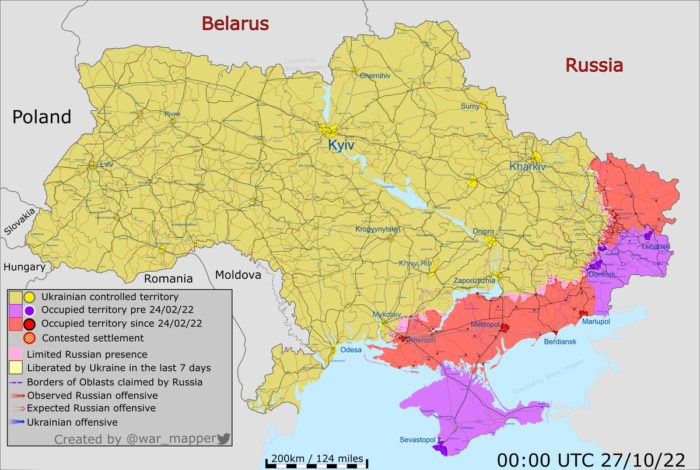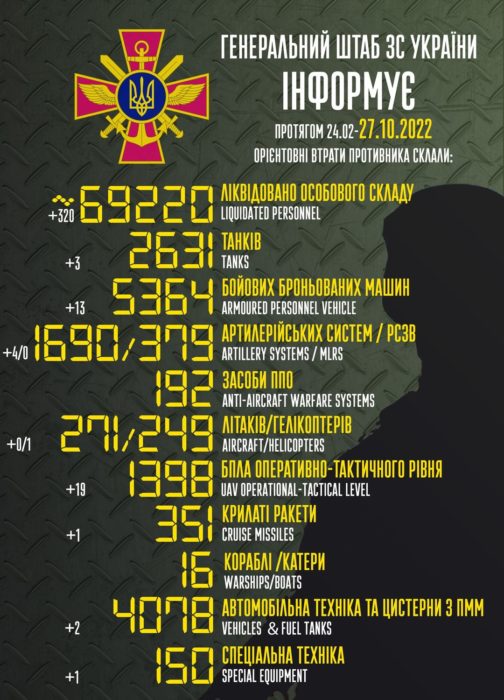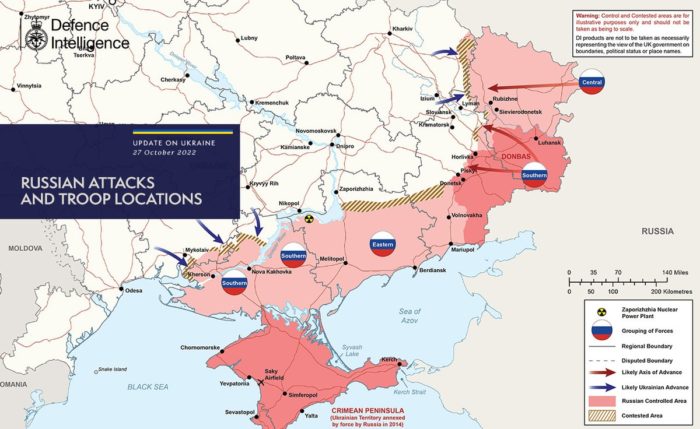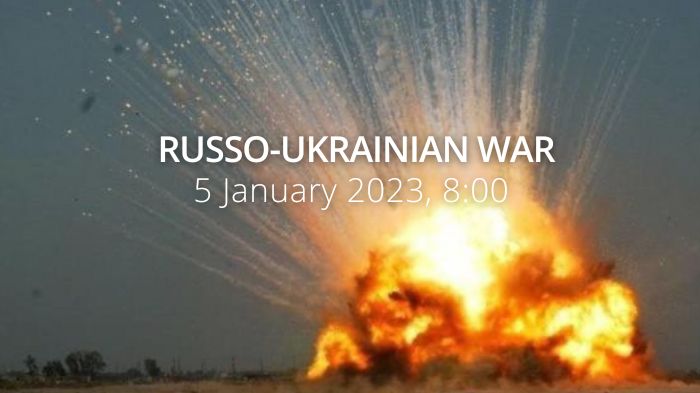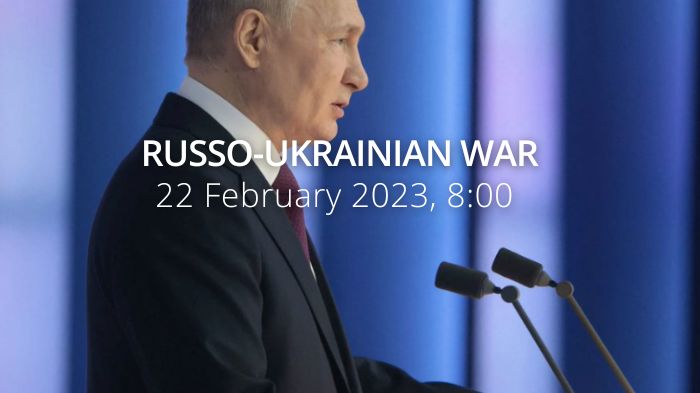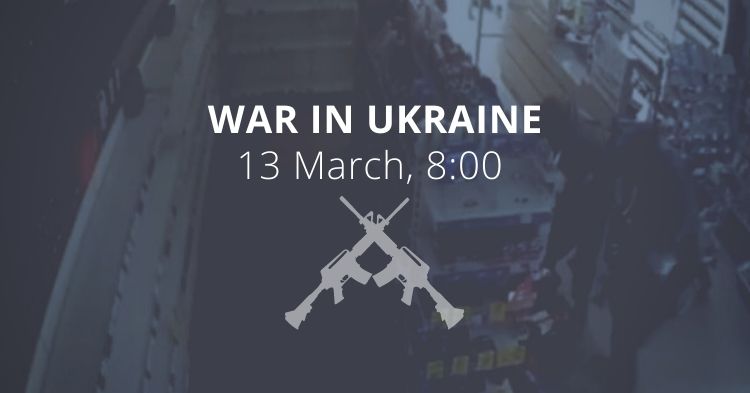Daily overview — Summary report, October 27
According to information from the General Staff as of 06.00 27.10.2022, supplemented by its [18:00 assessment]:
“Russian forces are trying to hold the temporarily captured territories, concentrating efforts on restraining the actions of the Defense Forces in certain directions, while at the same time not stopping offensive operations in the Bakhmut and Avdiivka directions.
During the day, units of the Defense Forces repelled the attacks of the occupiers in the areas of the settlements of Bilohorivka in the Luhansk oblast and Bakhmut, Ivangrad, Soledar, Mayorsk, Krasnohorivka and Mariinka in the Donetsk oblast.
Russian forces are shelling the positions of our troops along the line of contact, carrying out fortification equipment of positions in certain directions, in particular, on the left bank of the Dnipro River, actively conducting aerial reconnaissance.
In violation of international humanitarian law, laws and customs of war, the Russian occupiers continue to destroy critical infrastructure and civilian homes.
During the day, Russian forces launched 18 airstrikes, 4 missile strikes and 56 MLRS attacks.
The cities of Kupiansk, Druzhkivka and Zaporizhzhia were hit by enemy attacks.
The situation in the Volyn and Polissya directions has not changed significantly. The Republic of Belarus continues to support the armed aggression of the Russian Federation against Ukraine, providing its territory, airspace and infrastructure. There is still a threat of missile and air strikes, including the use of attack UAVs.
Russian forces shelled in other directions:
- in the Slobozhansk direction - from the territory of the Russian Federation, using mortars, artillery and MLRS, in the areas of Chuhunivka, Strilecha, Dvorichna, Kamianka, Krasne and Starytsa settlements;
- in the Kupiansk direction - from tanks, mortars, artillery and MLRS, in the areas of the settlements of Berestovka, Kislivka, Kotlyarivka and Fiholivka;
- in the Lymansky direction - from tanks, mortars, artillery and MLRS in the areas of Hrekivka, Druzhelyubivka, Makiivka, Terny, Torske, Yampolivka, Spirne, Nevske, Verkhnyokamianske and Zarichne settlements;
- in the Bakhmut direction - from tanks and MLRS, in the areas of Andriivka, Bakhmut, Bakhmutske, Soledar, Mayorsk, New York, Yakovlivka, Zelenopillia and Ozaryanivka settlements;
- in the Avdiivsk direction, Russian forces inflicted fire damage in the areas of Mariinka, Vodyane, Novomykhailivka, Pervomaiske, Avdiivka, Krasnohorivka, Oleksandropil and Novokalynove settlements.
- in the Novopavlivsky and Zaporizhzhia directions, Russian forces carried out artillery shelling in the areas of the settlements of Orihiv, Vremivka, Dorozhnyanka, Malynivka, Novoukrainka, Hulyaipole, Zaliznychne, Novopil, Neskuchne, Olhivske, and Biloghirya.
- In the Pivdennyy Buh direction - Areas of 20 settlements, not far from the contact line, were damaged by fire. Nikopol suffered from the MLRS fire.
Russian servicemen mobilized a week ago, continue to arrive on the temporarily captured territory of the Zaporizhzhia region. The specified personnel lack motivation and desire to participate in hostilities on the territory of Ukraine, not the rare cases of desertion are recorded.
[Russian invaders are restricting the right of free movement of civilians in the temporarily occupied territories. So, local residents of Pershotravneve settlement of Kharkiv oblast are prohibited from leaving the village.]
[In the Russian Federation, work continues on the replenishment of combat losses. The recruitment by representatives of private military campaigns of prisoners in prisons in the city of Bryansk and Bryansk region was noted.]
[According to the updated information, the results of fire damage to Russian forces during the last days have been confirmed. Thus, in the districts of Korzhov and Mykolaivka settlements of the Luhansk region, the occupiers lost up to 60 people, including at least 10 officers.]
Russian forces continue to replenish losses. According to available information, representatives of private military campaigns are recruiting prisoners in correctional facilities in the city of Ulyanovsk. Most of the persons of the specified category who agree to fight on the territory of Ukraine are convicted of murder, rape and sale of narcotics.
Russian forces continue to suffer losses. Fire damage to the area of the concentration of weapons and military equipment, Russian ammunition depots on October 25 of this year in the area of Beryslav settlement of the Kherson region was confirmed. Personnel losses are being clarified.
On October 24-25, about 100 wounded enemy servicemen were brought to the city hospital of the settlement of Holubivka, Luhansk region. Several surgical teams arrived from Luhansk and Kadiivka to assist.
The aviation of the Defense Forces made 5 strikes during the past day. It has been confirmed that in the area where Russian manpower, weapons and military equipment are concentrated, 3 strongholds and an anti-aircraft missile complex have been destroyed. During the previous day, air defense units shot down an enemy Ka-52 helicopter, a Kh-59 missile and 17 enemy attack UAVs.
During the day, soldiers of the missile troops and artillery struck 4 control points, 8 areas of concentration of manpower, weapons and military equipment, 3 warehouses with ammunition and 6 other important military objects of Russian forces.“
Ingenious mobile app helps down first Russian missile in Ukraine, Ukrinform reports. “In Ukraine, a Russian missile was shot down for the first time with the assistance of the ePPO (e-air defense) mobile application available to all users who are required to register through the Diia national portal of digital government services. […] It (missile - ed.) flew at a very low altitude, taking into account the peculiarities of the terrain, invisible to radars. But several vigilant citizens spotted the missile and immediately notified the military using the ePPO application. Our anti-aircraft units received targeting in a few seconds and shot the Kalibr down using Igla MANPADS without too much trouble, just like on a simulator,” [Hennadiy Suldin, one of the app developers], said.
According to the developer, ePPO was conceived precisely as a means of tracking low-flying subsonic cruise missiles, first of all the Kalibrs.”
Armed Forces of Ukraine holding active defence in Kherson region, Ukrinform reports. "The battles are going on there. The General Staff describes them as defensive actions, within the framework of which some offensive operations are carried out. Over the past week, the intensity of developments at the front has somewhat decreased, and we hold the active defense," Deputy Defense Minister of Ukraine Hanna Maliar said […]. The situation remains under control, she stressed. We are not losing territory, the deputy minister assured.”
According to British Defence Intelligence, (last 48 hours):
- On 24 October 2022, Russian Prime Minister Mikhail Mishustin said that Moscow Mayor Sergey Sobyanin will coordinate the ‘development of security measures’ in Russia’s regions. This followed Russian President Vladimir Putin’s decree introducing a new regimen of security alert levels.
- This measure is likely to lead to a closer interlinking of regional governors into Russia’s national security system. It is a further measure to organise society as Russia’s war against Ukraine continues to be under pressure.
- The greater involvement of regional officials is likely at least partially designed to deflect public criticism away from the national leadership. The Kremlin pursued a similar approach during the COVID-19 crisis. However, it will likely make it more difficult for the Kremlin to insulate Russian society from the effects of the ‘special military operation’ in Ukraine.
- On 24 October 2022, the governor of Russia’s Belgorod region announced that an explosive device had damaged the railway near the village of Novozybkovo, approximately 15km from the Russia-Belarus border. The line is the main rail link between Russia and southern Belarus.
- The Russian anti-war group ‘Stop the Wagons’ (STW) claimed responsibility for the incident. This is at least the sixth incident of sabotage against Russian railway infrastructure claimed by STW since June. This is part of a wider trend of dissident attacks against railways in both Russian and Belarus. The Russian authorities have previously clamped down on STW’s online presence.
- The Russia military primarily relies on rail transport for deploying forces to Ukraine, but with a network extending to over 33,000km, largely transiting isolated areas, the system is extremely challenging to secure against physical threats. The Russian leadership will be increasingly concerned that even a small group of citizens has been sufficiently opposed to the conflict to resort to physical sabotage.
As of Thursday 27 October, the approximate losses of weapons and military equipment of the Russian Armed Forces from the beginning of the invasion to the present day are:
- Personnel – more than 69220 (+320),
- Tanks – 2631 (+3),
- Armoured combat vehicles – 5364 (+13),
- Artillery systems – 1690 (+4),
- Multiple rocket launchers –MLRS - 379 (+0),
- Air defence means – 192 (+0),
- Aircraft - 271 (+0),
- Helicopters - 249 (+1),
- Automotive technology and fuel tanks – 4078 (+2),
- Vessels/boats - 16 (+0),
- UAV operational and tactical level – 1398 (+19),
- Special equipment – 150 (+1),
- Mobile SRBM system – 4 (+0),
- Cruise missiles – 351 (+1)
Military Updates
Russia will need 5 years to restore stocks of missiles due to sanctions, Ukrainska Pravda reports. “The Ukrainian authorities believe that it will take 5 years for Russia to restore its prewar stock of high-precision missiles. Sanctions are keeping them from acquiring parts". The source added that Russia will be able to produce missiles "little by little" using existing reserves, but "at a slower pace and in smaller quantities.
In almost eight months of full-scale war, according to the Minister of Defence of Ukraine Oleksii Reznikov, Russia has used up two-thirds of its arsenal of high-precision missiles. As of October 14, it had approximately 609 of 1,844 such munitions left.
The head of Ukrainian defence intelligence, Kyrylo Budanov, said that Russia is already using its remaining stock of Iskanders (13% left) and is still trying to "stay within its norms" with regard to Kalibrs and the Kh-101 and Kh-555 missiles (43% and 45% remaining, respectively).
The Russians are already using Iranian-made kamikaze drones, and are allegedly planning to use Iranian-made ballistic missiles as well as Iranian helmets and body armour for newly mobilised recruits.”
Drivers and mechanics conscripted for the needs of Russian troops in Belarus, Ukrainska Pravda reports, citing National Resistance Center (NRC). “Local military enlistment offices in Gomel Oblast, Belarus, are conducting covert mobilisation of drivers and mechanics, reported the Belarusian underground resistance. (Military) commissars are visiting the places of residence of persons liable for military service. They are looking for truck drivers and mechanics. These conscripts are involved in the maintenance of military equipment of the Armed Forces of the Russian Federation deployed on the territory of Belarus.
The NRC also reported that the Belarusian military has been spotted near temporarily occupied Melitopol in Zaporizhzhia Oblast.”
According to British Defence Intelligence, (last 48 hours):
- On 24 October 2022, Russian Prime Minister Mikhail Mishustin said that Moscow Mayor Sergey Sobyanin will coordinate the ‘development of security measures’ in Russia’s regions. This followed Russian President Vladimir Putin’s decree introducing a new regimen of security alert levels.
- This measure is likely to lead to a closer interlinking of regional governors into Russia’s national security system. It is a further measure to organise society as Russia’s war against Ukraine continues to be under pressure.
- The greater involvement of regional officials is likely at least partially designed to deflect public criticism away from the national leadership. The Kremlin pursued a similar approach during the COVID-19 crisis. However, it will likely make it more difficult for the Kremlin to insulate Russian society from the effects of the ‘special military operation’ in Ukraine.
- On 24 October 2022, the governor of Russia’s Belgorod region announced that an explosive device had damaged the railway near the village of Novozybkovo, approximately 15km from the Russia-Belarus border. The line is the main rail link between Russia and southern Belarus.
- The Russian anti-war group ‘Stop the Wagons’ (STW) claimed responsibility for the incident. This is at least the sixth incident of sabotage against Russian railway infrastructure claimed by STW since June. This is part of a wider trend of dissident attacks against railways in both Russian and Belarus. The Russian authorities have previously clamped down on STW’s online presence.
- The Russia military primarily relies on rail transport for deploying forces to Ukraine, but with a network extending to over 33,000km, largely transiting isolated areas, the system is extremely challenging to secure against physical threats. The Russian leadership will be increasingly concerned that even a small group of citizens has been sufficiently opposed to the conflict to resort to physical sabotage.
Humanitarian
‘Energy genocide’: Ukraine pleads for urgent help as Russia blitz on infrastructure grows, Independent reports. “Russia is committing “energy genocide” by bombing nearly half of Ukraine’s power infrastructure, the government has said as Ukrainian officials warned the damage could spark Europe’s worst humanitarian catastrophe since the Second World War. Speaking to The Independent, energy minister German Galushchenko said Russia wanted to “sow darkness and despair” with daily “en masse” strikes on the electricity supply chain, which together with the occupation of facilities, has left many without power.
He said at least 40 per cent of its total energy infrastructure has been damaged, including massive destruction to green generation facilities. In total, 90 per cent of Ukraine’s wind generation and 40 per cent of their solar power capacity has been decommissioned, he added. Mr Galushchenko spoke as Ukrainian energy officials warned the wave of strikes since 10 October was likely the largest attack on energy infrastructure in history.
They said the situation was so critical that Ukraine has had to stop providing electricity to the European Union, exports which had been helping Europe to replace Russian energy resources.
Russia cannot win on the battlefield by giving in to our armed forces, so it has decided to go down the path of energy genocide, Mr Galushchenko said. The Russians are intentionally attacking our energy facilities right now, when the cold has started and energy supply is of particular value to citizens. Their plan is to sow not only darkness but also despair among Ukrainians. […]
Volodymyr Kudrytskyi, chairman of Ukrenergo, Ukraine’s grid operator, told The Independent the barrage of strikes was the biggest attack on energy infrastructure in history. The scale of these attacks is unseen in the world, he said. We are speaking about hundreds of missiles launched specifically at electricity transmission infrastructure. I cannot remember any other instance [where] we have seen such a scale of destruction.
Meanwhile, Antonina Antosha, from DTEK, the largest private energy investor in Ukraine which controls multiple power plants, warned the damage will leave millions of people in the country without light and heat, sparking the biggest humanitarian disaster since 1945. We are convinced that this is only the beginning and that attacks on other objects will continue. The craziest scenario is an attack on a nuclear power plant, she added. […]
The European Commission has urged European Union countries and companies to donate more money and equipment to support the energy sector in Ukraine. But the energy ministry said it needed air defence systems to halt the strikes, as reconstructing power plants and substations was pointless if they get hit again.
Our skies still need protection. Protection, including for energy and nuclear facilities, he said. We need air defence systems, we needed them yesterday.”
10 more Ukrainian soldiers released from Russian captivity, Ukrainska Pravda reports, citing Andrii Yermak, Head of the President’s Office of Ukraine. “According to Yermak, an officer and 9 privates and sergeants have been released from Russian captivity. The body of an American volunteer, US Army veteran Joshua Alan Jones, who fought for Ukraine and died in a battle with the Russian invaders, has been handed over to the Ukrainian side as well.”
UN aid chief 'relatively optimistic' Black Sea grain export deal to be extended, Reuters reports. “United Nations aid chief Martin Griffiths said on Wednesday that he was "relatively optimistic" that a UN-brokered deal that allowed Ukraine Black Sea grain exports would be extended beyond mid-November.
Griffiths travelled to Moscow with senior UN trade official Rebeca Grynspan earlier this month for discussions with Russian officials on the deal, which also aims to facilitate exports of Russian grain and fertilizer to global markets.”
Russia blocks 175 ships operating as part of ‘grain initiative’ – President of Ukraine, Ukrinform reports. “It is obvious that Russia once again intends to exacerbate the global food crisis, bring back the threat of large-scale famine. And this, in particular, is the responsibility of all our partners – after all, to guarantee food security and put an end to this dirty Russian game with hunger. Currently, due to Russia deliberately slowing down our food exports, the number of vessels waiting for an opportunity to perform contractual obligations has already reached 175, Zelensky said.
In his words, this is not just some trade issue. This is the deterioration of access to food for millions of people and the threat of an even greater increase in prices for basic products in Africa, Asia and Europe.”
Millions of refugees from Ukraine have crossed borders into neighbouring countries, and many more have been forced to move inside the country. The escalation of conflict in Ukraine has caused civilian casualties and destruction of civilian infrastructure, forcing people to flee their homes seeking safety, protection and assistance the UNHCR reports. As of 25 October:
| Individual refugees from Ukraine recorded across Europe: | 7,751,169 |
| Hungary, Republic of Moldova, Poland, Romania, Slovakia | 2,289,386 |
| Russian Federation, Belarus | 2,868,248 |
| Other European countries | 2,868,327 |
| Refugees from Ukraine registered for Temporary Protection or similar national protection schemes in Europe: | 4,426,745 |
| Hungary, Poland, Romania, Slovakia | 2,270,766 |
| Other European countries | 2,155,979 |
| Border crossings from Ukraine (since 24 February 2022): | 14,591,581 |
| Border crossings to Ukraine (since 28 February 2022): | 7,144,217 |
Environmental
Volodymyr Zelenskyy urges Ukrainians to conserve electricity
, Ukrainska Pravda reports. "Russian terrorists have created such difficult conditions for our energy sector professionals, such that no one in Europe has ever seen or met before. There have been no such threats as the ones that our experts are now forced to overcome. And yet they are overcoming them with honour...
In many cities and districts of Ukraine, emergency power outages occur regularly, and energy consumption has to be limited. But we must all remember one thing: we need a victory over Russia in the energy sector as well."
Ukraine refugees told not to return yet as energy crisis looms, The Guardian reports. “Ukraine’s government is advising refugees living abroad not to return until the spring amid mounting fears over whether the country’s damaged energy infrastructure can cope with demand this winter. The energy crisis comes as officials in Kyiv warned that the coming winter may herald the heaviest fighting of the war, around the southern city of Kherson where Russian forces have been digging in.
With a third of the country’s energy sector compromised by recent Russian missile and drone attacks Ukraine’s deputy prime minister Iryna Vereshchuk warned: The networks will not cope. You see what Russia is doing. We need to survive the winter, she added. The warning was delivered after a period in which, polling suggested, more Ukrainian refugees had expressed a desire to return home.
Vereshchuk said that although she would like Ukrainians to return in the spring, it was important to refrain from returning for now because the situation will only get worse. If it is possible, stay abroad for the time being.”
Legal
Russia's Security Council claims there are "hundreds of sects" in Ukraine and demands "desatanisation", Ukrainska Pravda reports, citing RIA Novosti. “Aleksey Pavlov, assistant secretary of the Security Council of the Russian Federation, has said that Ukraine should be "desatanised". Pavlov claims that Ukraine has turned into a "totalitarian hypersect" where citizens have abandoned Orthodox values, and therefore "desatanisation" is becoming an urgent issue. Pavlov admits that the exact number of sects in Ukraine is unknown, but the number is in the hundreds."
About 1000 bodies of the dead were exhumed in liberated territories, Ukrainska Pravda reports, citing the Ministry for the Reintegration of Temporarily Occupied Territories of Ukraine. "As a result of the search operations, about 1000 bodies of fallen heroes and civilians have already been exhumed. In particular, almost 450 at the site of one of the largest mass burial sites in Izium.
The shocking facts about the atrocities of the occupiers are being revealed: the dead include not only military personnel but also civilians, including both adults and children. But the exact information will become known only after expert analysis."
Ukraine’s media regulator wants three Russian TV channels to be recognized as “terrorist organizations”, Ukrinform reports, citing the Council’s press service. “The National Council on Television and Radio Broadcasting appealed to the law enforcement agencies of Ukraine regarding the recognition of the Russian TV channels Rossiya 24, RTR Planeta, and Perviy as terrorist organizations.
In their broadcasts, the TV channels Rossiya 24, RTR Planeta, and Perviy, reporting terrorist acts in Vinnytsia, Olenivka, and Chaplyne, misinformed their audience, disseminated information selectively, gave certain advantages in covering facts, which is exclusively a propaganda activity aimed at to incite war and ensure its support by the audience of these TV channels, the regulator says. […]
RTR Planeta, Rossiya 24, and Perviy belong to the poll of mass media in which the terrorist state (aggressor state) - the Russian Federation - has an ownership share. All editorial decisions regarding circulated information belong only to broadcasters, their management, and journalists. Therefore, the responsibility for the dissemination of information by these mass media that justifies, incites, and supports terrorism is a media component of Russia’s state-sponsored terrorism against Ukraine, the National Council stated.”
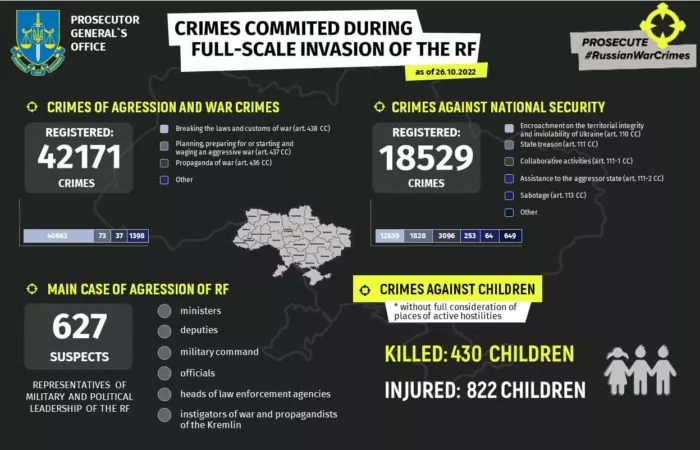 430 children were killed, 822 children injured, 9,441 deported by foe forces, and 244 reported missing - the Office of the Prosecutor General of Ukraine reports as of October 27. 2,677 educational establishments are damaged as a result of shelling and bombings, and 331 of them are destroyed fully. 42,171 crimes of aggression and war crimes and 18,529 crimes against national security were registered as of October 26.
430 children were killed, 822 children injured, 9,441 deported by foe forces, and 244 reported missing - the Office of the Prosecutor General of Ukraine reports as of October 27. 2,677 educational establishments are damaged as a result of shelling and bombings, and 331 of them are destroyed fully. 42,171 crimes of aggression and war crimes and 18,529 crimes against national security were registered as of October 26.
Support
NATO will not allow Putin to win the war against Ukraine – Stoltenberg, Ukrinform reports. "Wars are by nature unpredictable. […] I will not speculate about how long the war will last. I will only say two things, and one is that we are ready to support Ukraine for as long as it takes. We cannot allow President Putin to win. That would be a disaster, a tragedy for Ukrainians, but it would also make us, NATO Allies, more vulnerable. Because then the lesson learned from Ukraine for President Putin is that he can achieve his goals by using military force. And that will be a lesson learned not only for him, but also for other authoritarian leaders around the world, [NATO Secretary General Jens] Stoltenberg said.”
Ukraine receives 2 NASAMS air defence systems from the US, The Kyiv Independent reports. “Raytheon Technologies, US-based aerospace and defence conglomerate, has delivered two NASAMS air defence systems due for Ukraine to the US government, its chief executive said on Oct 25. “We did just deliver two NASAMS systems. (...) We delivered two of them to the government a couple of weeks ago. They’re being installed in Ukraine today,” CEO Greg Hayes said on CNBC’s “Squawk on the Street” program.”
Australia to supply Ukraine with 30 more Bushmaster armoured vehicles, Ukrinform reports, citing ABC News. "Since their arrival [in Ukraine], the Bushmasters have been used extensively by the Ukrainian Armed Forces with more requested by the Ukrainian President, Minister for Defense, and the Ambassador," said Australian Defense Minister Richard Marles.
The 30 additional Bushmasters will bring the total number of protected mobility vehicles sent to Ukraine to 90. Also, after Catholic Christmas, Australia will send a contingent of up to 70 Australian Defense Force (ADF) personnel to Britain to help train Ukrainian soldiers.”
Ukraine needs short-range air defence systems for protection against Iranian drones – Reznikov, Ukrinform reports, citing Politico. "I get a clear signal from all sides that no matter what, the countries will support Ukraine until the end of this war, and I'm sure that the end of this war will mean victory for Ukraine, Reznikov said. He said he was optimistic that US-made Abrams tanks and F-16 fighter jets could be delivered to Ukraine in the future. I'm really optimistic that Abrams tanks are possible in the future and I am sure that fighter jets like F-16s, F-15s, or Gripen from Sweden will also be possible, Reznikov added.
He noted that while tanks and fighter planes remain a work in progress, air defences will continue to be priority number one in the coming months. We need to divide the targets in the air — for example, to strike cruise or ballistic missiles our defence systems will use … rockets like IRIS-T from Germany and [soon] there will also be [the National Advanced Surface-to-Air Missile System], or our Soviet systems like Buk. Against the Iranian drones we can use cheaper equipment like Gepard from Germany or Stingers and Starstreak, or other equipment from our partners, the minister added.
Bolstering that protective blanket over Kyiv and other cities remains top of mind for Ukrainian officials, as the missiles and drones keep coming, he said. That's why we ask our partners to find the solutions with different systems not only for the middle-range or long-range, we need short-range systems [from] different countries that have those systems like Sweden, Germany and the United States, Reznikov said.”
New developments
- Poland's Senate recognizes the Russian government as a terrorist regime, Ukrinform reports, citing Polskie Radio. “Poland's Senate on Wednesday voted for a resolution recognizing the Russian authorities as a terrorist regime. The Senate of the Republic of Poland once again strongly condemns Russian aggression and calls on all countries that advocate peace, democracy and human rights to recognize the government of the Russian Federation as a terrorist regime, the resolution reads.”
- "Don't escalate": Belarusian propaganda responds to Armed Forces of Ukraine using Kremlin rhetoric, Ukrainska Pravda reports, citing the Ministry of Defence of the Republic of Belarus. “Belarusian propaganda responded to the Armed Forces of Ukraine with Kremlin rhetoric when the Armed Forces called upon Belarus not to participate in the war against Ukraine. "The people of Belarus are replying to those who have not yet understood it. Or did not want to understand. There will be no war if you don’t want it! Don’t provoke us, don’t try to intimidate us, don’t escalate and everything will be as you want it. We don’t want war and don’t threaten anybody. But we will not hesitate to respond to provocations!"
- Stoltenberg warns Russia against lying about ‘dirty bomb’ in Ukraine, Ukrinform reports. “Russia now falsely claims Ukraine is preparing to use a radiological ‘dirty bomb’ on its own territory. NATO Allies reject this transparently false allegation. Russia often accuses others of what they intend to do themselves. We have seen this pattern before. From Syria to Ukraine. Russia must not use false pretexts for further escalation. The world is watching closely, NATO Secretary General Jens Stoltenberg said […]. NATO chief noted that Russia's brutal war against Ukraine was at a pivotal moment now. President Putin is responding to his failures on the battlefield with more aggression, strikes on civilians and civilian energy infrastructure, drone and missile attacks on residential areas.”
- Ukraine's defence minister says he doesn't believe Putin will use nuclear weapons, Reuters reports. “Ukraine's Defence Minister Oleksiy Reznikov said on Wednesday he did not believe Russia's President Vladimir Putin would use nuclear weapons. Putin has warned repeatedly that Russia has the right to defend itself using any weapons in its arsenal, which includes the world's largest nuclear stockpile. Russia's setbacks in the war in Ukraine have heightened Western concerns that Putin might use a tactical nuclear weapon.”
- Russian Defence Minister told Ministers of Defence of India and China about the alleged "dirty bomb", Ukrainska Pravda reports, citing the press service of the Ministry of Defence of Russia. “Sergei Shoigu, the Minister of Defence of Russia, called Rajnath Singh, the Minister of Defence of India, and Wei Fenghe, the Minister of Defence of China, to tell them about a so-called "dirty bomb".”
- Russian propaganda has already said that Ukraine is preparing to bring down a "radioactive missile" over Chornobyl; Ukrainska Pravda reports, citing RIA Novosti. “The propagandists [alledge] that "specialists of the Ukrainian enterprise Pivdenmash have prepared a dummy rocket, which is planned to be filled with radioactive material and then allegedly brought down over the exclusion zone of the Chornobyl nuclear power plant."
- Russia notifies the US it will carry out expected nuclear drills, Reuters reports. “Russia has notified the United States about its plans to carry out annual exercises of its nuclear forces, the US government said on Tuesday, a move that Washington said lowers the risk of miscalculation at a time of "reckless" Russian nuclear rhetoric. The United States has said it expects Russia to carry out test launches of missiles during its annual "Grom" exercises of its strategic nuclear forces, noting in the past it has fired inter-continental ballistic missiles.”
- Putin to use UN grain deal as leverage at G20, European diplomat says, Reuters reports. “Russian President Vladimir Putin is likely to use the possible extension of the UN-brokered Black Sea grain deal as a way to gain leverage and dominate next month's G20 summit in Indonesia, a European diplomat briefed on the grain talks told Reuters. Ahead of the Nov. 19 expiry of the grain deal, which allows Ukrainian Black Sea grain exports, Russian officials have repeatedly said that there are serious problems with it.”
Assessment
- On the War
The Institute for the Study of War has made the following assessment as of Wednesday 26 October:
Russian sources claimed that Ukrainian troops conducted counteroffensive operations west of Svatove on October 26.[…] Several milbloggers claimed that Russian forces repelled multiple attempted Ukrainian attacks toward Svatove. Another prominent milblogger posted a map that indicates that Ukrainian forces have advanced up to Dzherelne, about 16km due west of Svatove. […]
Footage posted to social media on October 26 shows a Ukrainian soldier raising a flag in Nevske, indicating that Ukrainian troops likely have taken control of the settlement, and Russian sources are trying to obfuscate the gain.[…]
Southern Ukraine: (Kherson Oblast)
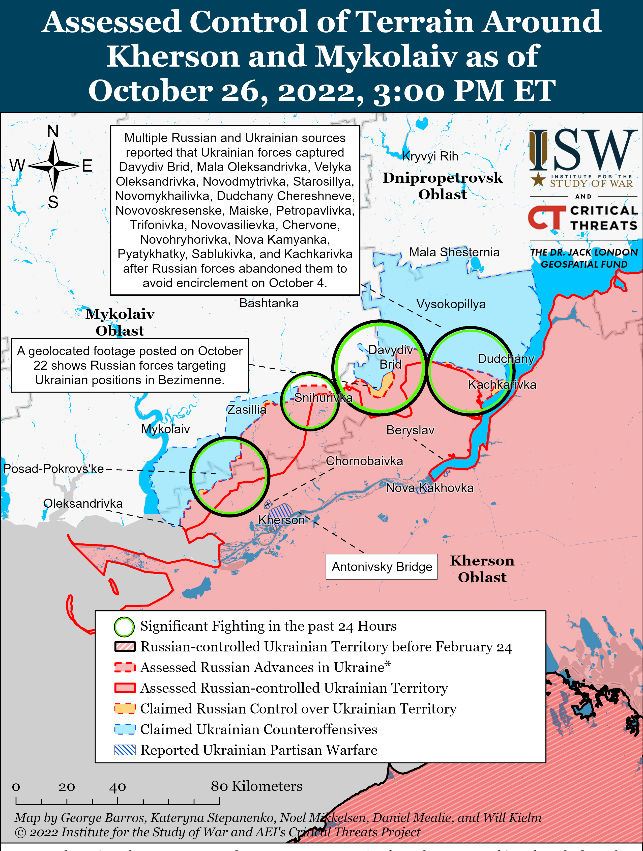 Russian forces continued to prepare for the defensive on both the west and east banks of the Dnipro River on October 26. The Ukrainian General Staff reported that Russian forces are continuing to prepare defensive positions on the east bank of the Dnipro River. The Ukrainian Resistance Center reported that Russian forces in Nova Kakhovka are preparing defences in the city for street fighting. Russian sources reported that Russian forces are building fortifications in Kherson City and creating strongholds in case of future Ukrainian breakthroughs, with one source calling the fortifications the “Surovikin Line.” Nova Kakhovka notably lies on the east bank of the Dnipro River, making Russian preparations for fighting in the city contrast with Russian claims that Russian forces intend to hold Kherson City and the west bank of the Dnipro. This may also indicate that Russian forces anticipate battles to take place on the east bank of the Dnipro River in Russian-occupied territory deeper in Kherson Oblast. Geolocated footage from October 26 shows a resident complaining about Russian forces withdrawing to the east bank of the Koshevaya River (5km southwest of Kherson City). These continued reports of Russian withdrawals from the area suggest that the Russian military does not expect to hold Kherson City even if it intends to fight for it.
Russian forces continued to prepare for the defensive on both the west and east banks of the Dnipro River on October 26. The Ukrainian General Staff reported that Russian forces are continuing to prepare defensive positions on the east bank of the Dnipro River. The Ukrainian Resistance Center reported that Russian forces in Nova Kakhovka are preparing defences in the city for street fighting. Russian sources reported that Russian forces are building fortifications in Kherson City and creating strongholds in case of future Ukrainian breakthroughs, with one source calling the fortifications the “Surovikin Line.” Nova Kakhovka notably lies on the east bank of the Dnipro River, making Russian preparations for fighting in the city contrast with Russian claims that Russian forces intend to hold Kherson City and the west bank of the Dnipro. This may also indicate that Russian forces anticipate battles to take place on the east bank of the Dnipro River in Russian-occupied territory deeper in Kherson Oblast. Geolocated footage from October 26 shows a resident complaining about Russian forces withdrawing to the east bank of the Koshevaya River (5km southwest of Kherson City). These continued reports of Russian withdrawals from the area suggest that the Russian military does not expect to hold Kherson City even if it intends to fight for it.
Russian sources claimed that Ukrainian forces continued to conduct counteroffensive operations in northwestern Kherson Oblast on October 26. […] Elements of the Russian 11th Guards Air Assault Brigade are reportedly operating in northeastern Kherson Oblast, likely near or in the Beryslav Raion. Ukrainian military officials largely maintained operation silence regarding Ukrainian ground maneuvers in Kherson Oblast on October 26. Ukraine’s Southern Operational command noted that Ukrainian troops repelled a Russian attempt to break through Ukrainian lines in an unspecified direction on October 25. Ukrainian military sources also reiterated that Ukrainian troops are continuing their interdiction campaign to target Russian concentration areas in Kherson Oblast. Ukraine’s Southern Operational Command reported that Ukrainian forces conducted more than 150 fire missions in the Southern Bug direction on October 26 but did not specify any Russian targets that were struck.
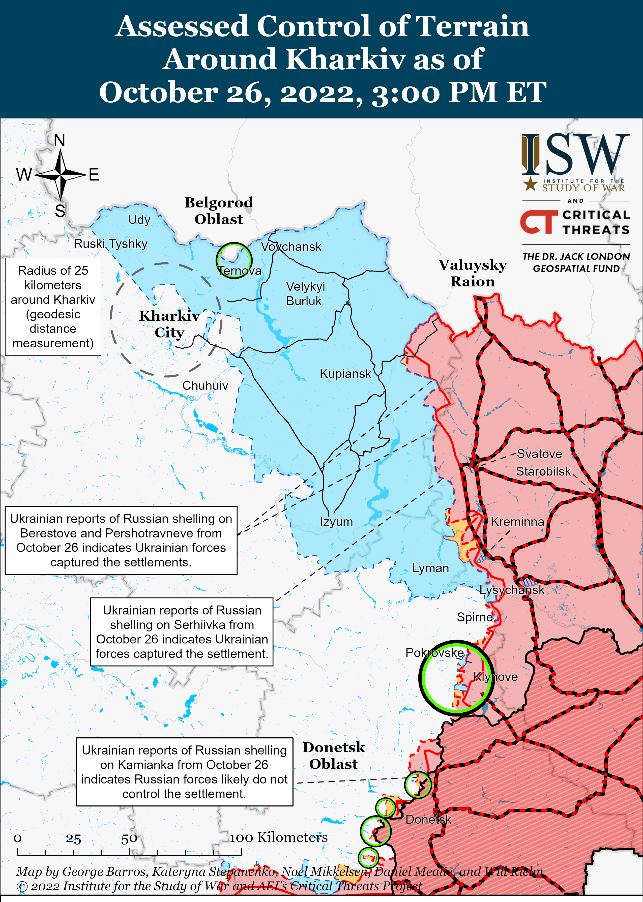 A Reuters investigation of a document trove found in an abandoned Russian command post in Balakliya, Kharkiv Oblast, supports ISW’s longstanding assessments about the poor condition of Russian forces. ISW has long assessed that the conventional Russian military in Ukraine is severely degraded and has largely lost offensive capabilities since the summer of 2022, that Russian strategic commanders have been micromanaging operational commanders' decisions on tactical matters, and that Russian morale is very low. Reuters’ investigation found that Russian units near Balakliya were severely understrength, with a combat battalion at 19.6-percent strength and a reserve unit at 23-percent strength. The investigation found that poor morale, bad logistics, and overbearing commanders contributed to Russian forces’ poor performance. The report found that the Russian Western Military District explicitly forbade a subordinate from withdrawing from an untenable position in the small village of Hrakove (which has an area of less than three square kilometers). Ukrainian forces defeated Russian forces in Balakiya and routed Russian forces in eastern Kharkiv Oblast around September 8-10.
A Reuters investigation of a document trove found in an abandoned Russian command post in Balakliya, Kharkiv Oblast, supports ISW’s longstanding assessments about the poor condition of Russian forces. ISW has long assessed that the conventional Russian military in Ukraine is severely degraded and has largely lost offensive capabilities since the summer of 2022, that Russian strategic commanders have been micromanaging operational commanders' decisions on tactical matters, and that Russian morale is very low. Reuters’ investigation found that Russian units near Balakliya were severely understrength, with a combat battalion at 19.6-percent strength and a reserve unit at 23-percent strength. The investigation found that poor morale, bad logistics, and overbearing commanders contributed to Russian forces’ poor performance. The report found that the Russian Western Military District explicitly forbade a subordinate from withdrawing from an untenable position in the small village of Hrakove (which has an area of less than three square kilometers). Ukrainian forces defeated Russian forces in Balakiya and routed Russian forces in eastern Kharkiv Oblast around September 8-10.
Russian President Vladimir Putin’s rhetoric indicates that he is not interested in negotiating seriously with Ukraine and retains maximalist objectives for the war. Putin stated that Ukraine has “lost sovereignty” in a meeting with Commonwealth of Independent States (CIS) security officials on October 26. Putin stated that the United States is using Ukraine as a “battering ram” against Russia, the Russian-Belarusian Union State, the Collective Security Treaty Organization, and the CIS. Russian State Duma Speaker Vyacheslav Volodin amplified this narrative, stating that “Ukraine has lost the ability to exist as a state,” “Ukraine is occupied by NATO,” and “[Ukraine] has become a colony of the US” on October 26. This language is incompatible with negotiations on an equal basis for a ceasefire, let alone a resolution to the conflict that Russia began. It instead strongly suggests that the Kremlin still seeks a military victory in Ukraine and regime change in Kyiv that would affect the permanent reorientation of Ukraine away from the West and into Russia’s control. It also indicates that Putin’s aims transcend the territory he has claimed to have annexed, let alone the areas his forces actually control.
Russian occupation officials in Kherson Oblast are attempting to mitigate the informational consequences of the chaos of the initial Russian withdrawals from the west bank of the Dnipro River. Kherson Oblast occupation head Vladimir Saldo stated on October 26 that it would be “practically impossible” to completely destroy the dam at the Kakhovka hydroelectric power plant (HPP) and that even the destruction of the dam locks at the HPP would only cause the water level of the Dnipro River to rise less than 2 meters. Saldo’s statement directly contradicts his own prior statements and the warnings made by Commander of Russian Armed Forces in Ukraine Army General Sergey Surovikin on October 18 that Ukraine is planning to strike the Kakhovka HPP and cause flood damage along the Dnipro River. Saldo’s apparent retraction of his own warnings may suggest that he seeks to quell anxiety accompanying the mass movement of civilians and Russian military and occupation elements across the Dnipro in order to preserve his own ability to rule. Saldo also issued assurances about the provision of basic utilities and financial services that he claimed will continue even as evacuations to the east bank are ongoing. Saldo’s statements indicate that his administration is attempting to mitigate panic in the information space, likely in order to maintain control of the population of Kherson Oblast against the backdrop of ongoing evacuations.
Russian forces conducted an assault on Ternova, Kharkiv Oblast, likely to fix Ukrainian forces there and prevent them from reinforcing Ukrainian counteroffensive operations elsewhere. The Ukrainian General Staff reported on October 26 that Ukrainian forces repelled an attack on Ternova (40km northeast of Kharkiv city) which is well removed from areas encompassed by the eastern Ukrainian counteroffensive. Russian forces likely do not intend to regain limited territory in border areas of Kharkiv Oblast but instead likely hope to keep Ukrainian forces in the area that otherwise could join counteroffensive operations. Russian forces are likely hoping for a similar outcome in northwestern Ukraine with their deployment of forces to the joint grouping of forces in Belarus and the messaging around it. […]
Key Takeaways
- Putin stated that Ukraine has “lost its sovereignty” in an October 26 speech indicating that Russia likely retains its maximalist objectives in Ukraine and remains resistant to negotiations.
- Russian occupation officials in Kherson Oblast are attempting to mitigate the informational consequences of the Russian withdrawal from the west bank of the Dnipro River.
- Russian forces are attempting to fix Ukrainian forces on Ukraine’s northern border.
- Russian officials continued to acknowledge that Russian authorities are deporting Ukrainian children to Russia under the guise of adoption and vacation schemes.
- Russian sources claimed that Ukrainian forces conducted counteroffensive operations west of Svatove.
- Russian forces continued to prepare defensive positions on the west and east banks of the Dnipro River in Kherson Oblast.
- Russian sources claimed that Ukrainian forces continued to conduct counteroffensive operations in northwest Kherson Oblast.
- Russian forces conducted ground attacks in Donetsk Oblast.
- The Russian military is reportedly attempting to recruit foreigners to support its war effort in Ukraine.
- Russian occupation officials in Kherson Oblast continued to relocate residents from the west bank of the Dnipro River.“
Ukraine's Minister of Defence doubts Russians will stay in Kherson until street fights break out, Ukrainska Pravda reports, citing Fox News. “Oleksii Reznikov, the Minister of Defence of Ukraine, doubts that Russian troops will dare to fight directly on the streets of Kherson. You know that we control all the bridges across the Dnipro using American systems like the HIMARS, as well as other MLRS like the M270, and 155 mm artillery; all these are modern NATO standard systems like the M777 from the US.
For them [the Russians], staying in Kherson is a real risk, because they will not have the chance to flee, as they did on the Kharkiv front, for example, or in Izium and other cities. Reznikov states that Russians will flee Kherson because it is risky for them to stay apart on different banks of the Dnipro.”
Ukraine’s advance in the south slows down due to rains, but it’s still there – Defence Minister, Ukrainska Pravda reports, citing Fox News. “The advance of Ukraine’s Armed Forces in the south has slowed down due to rainy weather conditions, but the Ukrainian defenders keep liberating the territories step by step.”
“Russian-installed authorities in Kherson city have been encouraging residents to flee, but Oleksiy Arestovych, adviser to Ukrainian President Volodymyr Zelensky, said there was no sign Russian forces themselves were preparing to withdraw”, Reuters reports.
Russia rehearses response to a nuclear attack as tensions rise over 'dirty bomb' allegation, Reuters reports. “Russia rehearsed its response to a nuclear attack on Wednesday in an exercise involving nuclear submarines, strategic bombers and ballistic missiles at a time when tensions are high over a "dirty bomb" allegation it has made against Ukraine. […] Defence Minister Sergei Shoigu told Putin the exercises had practised "delivering a massive nuclear strike by strategic offensive forces in response to an enemy nuclear strike".
Test launches of nuclear-capable intercontinental ballistic missiles from land and sea, and cruise missiles fired from the air by TU-95MS strategic bombers, had passed off successfully, Chief of Staff Valery Gerasimov added. […]
The Pentagon said a day earlier that Russia had notified it of its intention to carry out the exercises at a time when NATO is rehearsing its own use of US nuclear bombs based in Europe in its annual "Steadfast Noon" war games. Washington said the notification lowered the risk of miscalculation at a time of "reckless" Russian nuclear rhetoric, while Western officials have expressed confidence in their ability to discern the difference between a Russian drill and preparations for a real nuclear strike.
The nuclear muscle flexing is sensitive however, because Russia is on the back foot in Ukraine and has accused Ukraine of planning to detonate a "dirty bomb" laced with radioactive material, an allegation Putin repeated on Wednesday. Kyiv and the West say there is no evidence for the charge and that the warning looks designed to escalate tension around the war in Ukraine or to serve as the justification for some kind of Russian battlefield escalation.”
- Consequences and what to do?
Ukraine's external financing needs could reach $5 bln a month, IMF's Georgieva says, Reuters reports. “Ukraine's external financing needs will be around $3 billion a month through 2023 in a best-case scenario, but could rise as high as $5 billion if Russian bombing becomes "even more dramatic," IMF Managing Director Kristalina Georgieva said.
The International Monetary Fund is working with Ukrainian authorities to help define and implement the country's macroeconomic policies and what will be required to become a member of the European Union, as well as produce reliable financial projections, Georgieva told a conference in Berlin on Tuesday.”
Currency Depreciations Risk Intensifying Food, Energy Crisis in Developing Economies, The World Bank reports. “The shrinking value of the currencies of most developing economies is driving up food and fuel prices in ways that could deepen the food and energy crises that many of them already face, according to the World Bank’s latest Commodity Markets Outlook report. […]
Elevated prices of energy commodities that serve as inputs to agricultural production have been driving up food prices. During the first three quarters of 2022, food-price inflation in South Asia averaged more than 20 percent. Food price inflation in other regions, including Latin America and the Caribbean, the Middle East and North Africa, Sub-Saharan Africa, and Eastern Europe and Central Asia, averaged between 12 and 15 percent. East Asia and the Pacific has been the only region with low food-price inflation, partly because of broadly stable prices of rice, the region’s key staple. […]
Since the outbreak of the war in Ukraine, energy prices have been quite volatile but are now expected to decline. After surging by about 60 percent in 2022, energy prices are projected to decline 11 percent in 2023. Despite this moderation, energy prices next year will still be 75 percent above their average over the past five years. […]”
Hans Petter Midttun's assessment
While the West deny Ukraine a long-range strike capability over fears that Ukraine might attack legal targets on Russian territory, Russia is targeting illegal objects across all of Ukraine.
NATO and the US fear that support of combat aircraft, helicopters, main battle tanks or ATACMS will trigger a broader confrontation with Russia, ignoring the fact that Russia is already waging war against the West.
According to the EU, it has been waging a hybrid war against its member states for years. Its nuclear blackmail, terrorist strikes in Europe, coup attempt, assassinations, weaponizing of energy, food and information, political and economic warfare, instigation of the worst refugee crisis since WW2, and not least, willingness to use military power to achieve its strategic aim and objectives, impact not only our way of living but also our costs of living. Russian power projection – as weak and flawed as it might seem – has a global impact because of its brutality.
As Russian rhetorics grow increasingly belligerent and it keeps increasing the scope of cruelty and atrocities, we fear doing the right thing.
For the last 15 years, we have witnessed a continuous deteriorating global security situation partly because no one has been willing to defend international law and our core values and principles.
That trend is continuing despite our newfound “resolve”. Russia continues escalating the war against Ukraine and the West.
Recently we have seen:
- The illegal annexation of four Ukrainian oblasts.
- An increase in its nuclear threats, including its belligerent rhetoric, false narrative about a Ukrainian “dirty bomb”, irresponsible operations of and actions around the Zaporizhzhia Nuclear Power Plant and nuclear drills.
- Sabotage against subsea cables and pipelines in several regions, triggering concerns for the integrity of the wider Western energy and economic infrastructure.
- Increase in delays and waiting time for ships operating as part of ‘grain initiative’, causing concerns over exacerbating global food crisis and the risk of large-scale famine. There are concerns over Russia’s intentions to allow future exports when the present agreement ends on 22 November.
- Russia has increased its attacks on the civilian population and critical infrastructure in Ukraine. “Russia is committing “energy genocide” by bombing nearly half of Ukraine’s power infrastructure, the government has said as Ukrainian officials warned the damage could spark Europe’s worst humanitarian catastrophe since the Second World War. The attacks are assessed as war crimes by the international community.
Why is this happening? Because we have not yet stood up against the bully and demonstrated that we are willing to do what it takes. Because we keep all military options off the table, including humanitarian intervention under the UN Responsible to Protect doctrine. Because we keep watching atrocities take place without acting upon them. Because we are not responding to the war that is being waged against us in a manner Russia understands. Because NATO will rather face the “tsunami of ripple of effects” from the war than act according to its 2010 Strategic Concept.
While Europe has been in deep peace since the 90s, Russia has been in a state of constant conflict since early 2000. After nearly 9 years of war, we are still not “in the same room”. Russia is using all means to escalate, while the West insist on de-escalating without using the full range of means at its disposal to enforce its will.
This is why the statements of the Ukrainian Minister of Defence bring hope. When he is optimistic that Abrams tanks and fighter jets like F-16s, F-15s, or Gripen are possible in the future, we should share his optimism. He might know something the rest of us are hoping for.
More than 8 months after the full-scale invasion started – and after having both demonstrated tremendous courage, ingenuity and ability to employ modern, high-tech weapons with great effect – sufficient time has passed to allow the West to qualify Ukrainian soldiers for modern combat aircraft, helicopters, main battle tanks and air defence systems.
Has this been done? The next couple of months will show. But I chose to read Oleksii Reznikov’s statement optimistically. Western delivery of combat aircraft, helicopters, main battle tanks and air defence systems to Ukraine would be in line with NATO General Secretary Jens Stoltenberg’s statement:
“NATO will not allow Putin to win the war against Ukraine”
Especially since it in reality is a war against all of Europe.


